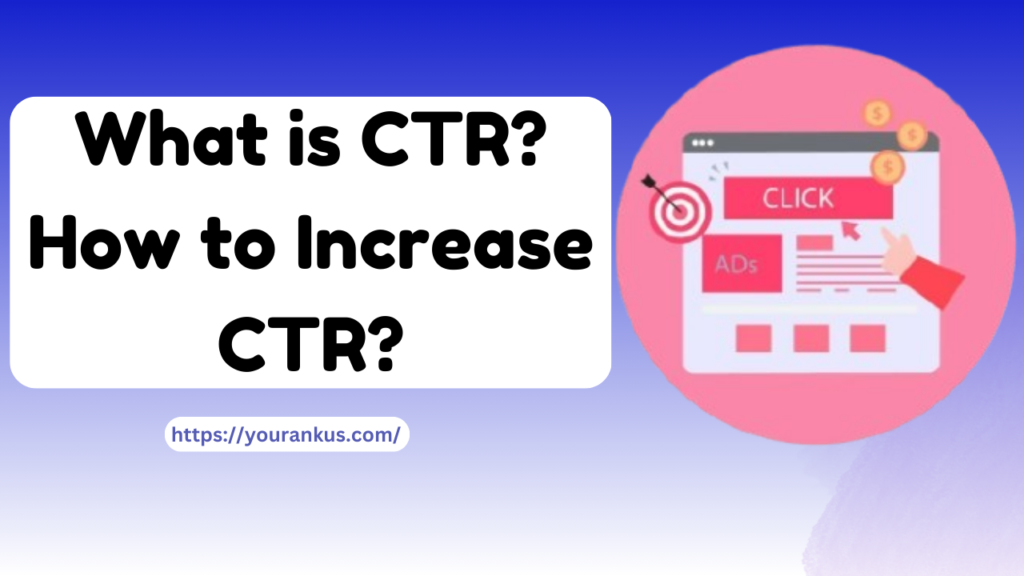In the ever-evolving world of digital marketing, one of the most important metrics used to measure success is the Click-Through Rate (CTR).
It is a crucial indicator that shows how well your content, ads, and overall digital strategy are performing in driving user engagement. Understanding CTR and knowing how to improve it can significantly enhance your marketing efforts.
In this blog post, we’ll dive into what CTR is, why it matters, and share actionable strategies to increase CTR across different marketing channels.
What is CTR?
CTR, or Click-Through Rate, is the percentage of people who click on a link, ad, or call-to-action (CTA) out of the total number of people who view it. It is calculated using the following formula:
CTR = (Number of Clicks / Number of Impressions) x 100
For example, if your ad is displayed 1,000 times (impressions) and 50 people click on it, your CTR would be:
(50 / 1000) x 100 = 5%
CTR is a key performance indicator (KPI) in digital marketing and is used to gauge the effectiveness of ads, email campaigns, landing pages, and other forms of digital content. A higher CTR generally suggests that your message is resonating with your audience and that your ad or content is enticing enough for people to take action.
Why Does CTR Matter?
CTR matters for several reasons:
- Engagement Indicator: It reflects how engaging your content or ad is. A low CTR suggests that your content isn’t appealing enough to your audience, while a high CTR means users find it compelling.
- Ad Relevance: Platforms like Google Ads and Facebook use CTR to determine the relevance of your ads. A higher CTR indicates that your ad matches the user’s search intent or interests, which can lead to lower costs and better ad placements.
- Cost Efficiency: For paid advertising, CTR is directly related to your cost-per-click (CPC). The higher your CTR, the more cost-effective your campaigns become, since you’re likely paying less per click.
- Improved SEO: For organic search results, higher CTRs on your listings signal to search engines like Google that your content is relevant to users, potentially boosting your rankings.
Factors That Influence CTR
Several elements can impact your CTR across different channels:
- Ad Copy/Content: Compelling and concise messaging increases the likelihood of clicks.
- Visuals: Attention-grabbing images or videos can significantly improve CTR, especially in social media ads.
- Targeting: Reaching the right audience ensures that your content or ads are relevant to the people who see them.
- Call-to-Action (CTA): Clear and persuasive CTAs encourage users to take the next step, like clicking a link or button.
- Relevance: Content that aligns with user intent is more likely to be clicked.
How to Increase CTR
Now that we’ve established why CTR is so important, let’s look at several proven strategies to increase it.
1. Optimize Your Headlines
Your headline is often the first thing people see, whether it’s an ad, a blog post, or an email. To improve CTR, your headlines need to be attention-grabbing, informative, and relevant to your audience. Use power words, ask questions, or create a sense of urgency.
For example:
- Instead of “Best Travel Tips,” try “Top 10 Travel Tips You Need to Know Before Your Next Trip!”
- Instead of “Buy Shoes Online,” try “Get 50% Off Today on Our Latest Shoe Collection!”
2. Create Compelling CTAs
A strong CTA can significantly increase your CTR. Make sure your CTA is clear, action-oriented, and relevant to the user’s journey. Instead of generic CTAs like “Click Here” or “Learn More,” use specific, benefit-driven language like:
- “Start Your Free Trial Now!”
- “Download Your Free Guide Today!”
- “Claim Your Discount Before It’s Gone!”
Also, consider using action verbs such as “discover,” “explore,” or “join” to encourage users to take immediate action.
3. Use A/B Testing
A/B testing involves creating two or more variations of your content, ad, or landing page to see which one performs better. By systematically testing elements such as headlines, CTAs, images, and even the placement of your ad or link, you can identify which variations lead to higher CTRs.
For example, test:
- Different ad copy to see which resonates better.
- The position of your CTA on a webpage.
- Different button colors to see if they prompt more clicks.
4. Leverage Emotional Triggers
Human decisions are often driven by emotion. To increase your CTR, craft content or ads that appeal to emotions like curiosity, urgency, fear of missing out (FOMO), or excitement. For instance:
- “Last Chance to Save 50% – Offer Ends Tonight!”
- “Don’t Miss Out on the Best Travel Destinations for 2024!”
Creating a sense of urgency can prompt users to act quickly, while curiosity-inducing content can encourage them to click to learn more.
5. Improve Ad Targeting
A well-targeted ad or piece of content will naturally have a higher CTR because it is shown to people who are more likely to be interested in it. Use data analytics to understand your audience’s demographics, behaviors, and preferences.
For paid ads, use audience segmentation features in Google Ads or Facebook Ads Manager to ensure your ads reach the right people. For example, target users based on location, age, gender, interests, and online behaviors.
6. Use High-Quality Visuals
Visual content is an effective way to grab attention and increase CTR. For social media and display ads, use high-quality images or engaging videos that are relevant to your content. Ensure that your visuals are designed to complement your message and reinforce your CTA.
For example:
- A travel company could use stunning images of tropical beaches to promote vacation packages.
- An e-commerce site could showcase close-up shots of their best-selling products in action.
7. Optimize for Mobile
More users are accessing the web via mobile devices, and if your content isn’t optimized for mobile, you risk losing clicks. Ensure that your website, landing pages, and ads are mobile-friendly, with fast loading times and responsive designs.
Additionally, make sure that CTAs and links are easy to click on mobile devices. Buttons should be large enough for touchscreens, and forms should be simple to fill out on smaller screens.
8. Use Rich Snippets and Structured Data
For SEO purposes, using rich snippets and structured data can make your content stand out in search engine results pages (SERPs). Rich snippets display additional information like ratings, reviews, or product details, making your listing more attractive and increasing the likelihood of a click.
For example, if you’re running an e-commerce store, implementing structured data to show product ratings in search results can make your listing stand out among competitors.
9. Write Meta Descriptions that Convert
Meta descriptions don’t directly impact search rankings, but they can significantly influence CTR. A well-crafted meta description should summarize the page’s content while including a clear value proposition. Keep it under 160 characters and incorporate relevant keywords to ensure users understand what they’ll gain by clicking through.
10. Monitor and Optimize Regularly
Improving CTR is not a one-time effort. Continuously monitor your campaigns, analyze the data, and make improvements based on performance. Tools like Google Analytics and advertising platforms provide insights into what’s working and what isn’t, allowing you to tweak your content, targeting, and other factors to boost CTR over time.
Conclusion
Click-through rate (CTR) is a vital metric for understanding how well your digital marketing efforts are driving user engagement. By optimizing your headlines, using compelling CTAs, leveraging emotional triggers, and consistently testing different elements, you can significantly improve your CTR.
Whether you’re running paid ads, email campaigns, or SEO efforts, these strategies will help you create more engaging content and ultimately drive more traffic to your website.
Improving CTR is an ongoing process that requires a balance of creativity, testing, and strategic thinking. As you refine your approach, you’ll see more effective campaigns and better results across the board.


